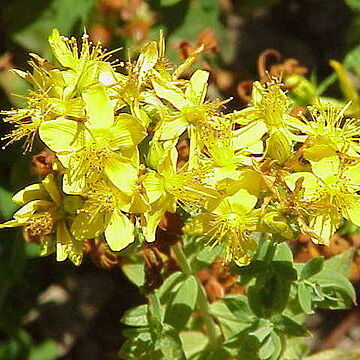Trees, shrubs, or herbs, hermaphrodite. Frequently glabrous or with simple or branched hairs. Coloured or clear resinous sap present in secretory canals or cavities. Leaves usually opposite (rarely whorled or alternate), simple, entire, exstipulate. Inflorescences terminal or axillary, flowers in cymes, or sometimes solitary, bracteate. Flowers actinomorphic; perianth of sepals and petals; calyx (2–) 4 or 5-merous, lobes free, imbricate, usually persistent in fruit; corolla (2–) 4 or 5-merous, free, imbricate. Stamens free, basally connate or substantially connate in bundles opposite and sometimes partly adnate to petals; anthers basifixed, bilocular, dehiscent by longitudinal slits. Staminodes and pistillode sometimes present; ovary of 3 or 5 carpels, superior, 3–5-locular with 1 to many ovules per locule; placentation axile or sometimes parietal; styles free or connate; stigma entire. Fruit usually a septicidal capsule, rarely a drupe. Seeds 1 to many, sometimes arillate, without endosperm.
Herbs, suffrutices, shrubs or trees, rarely climbers; juice resinous. Leaves opposite, verticillate or alternate, simple, often gland-dotted; stipules absent; indumentum often stellate. Inflorescence terminal, cymose-paniculate, or variously reduced to a single flower. Flowers regular, A5;. Sepals imbricate, often glandular. Petals imbricate or contorted, white, yellow or variously marked or tinged red. Stamens numerous, hypogynous, often united into bundles. Ovary 1–5-locular; styles usually free. Ovules numerous, few or solitary in each loculus, axile, ascending, rarely pendulous. Fruit a capsule, berry or drupe. Seeds without endosperm
Ovary of 3–5 (rarely 1) carpels, 1-celled or imperfectly or perfectly 2–5-celled; styles the same number as the carpels, slender, free or rarely somewhat united, with a terminal capitate to clavate stigma; ovules axile or pendulous, numerous and 2-seriate, or few or solitary
Leaves opposite or verticillate, rarely alternate, simple, entire or glandular-dentate, rarely coriaceous, usually thin and marked with translucent or black dots, rarely small and scale-like; stipules absent; indumentum when present often stellate and ferruginous
Stamens numerous or rarely subdefinite, hypogynous, usually variously united into 3–5 or more bundles, rarely free; anthers 2-celled, opening by longitudinal slits
Flowers terminal or rarely axillary, from solitary to cymosepaniculate or corymbose, usually yellow or white, hermaphrodite, actinomorphic
Fruit a septicidal or rarely loculicidal capsule, or a berry or drupe
Herbs, shrubs or rarely trees or climbers, with a resinous juice
Seeds without endosperm; embryo straight or arcuate
Petals 4–5, hypogynous, imbricate or contorted
Sepals 4–5, imbricate

